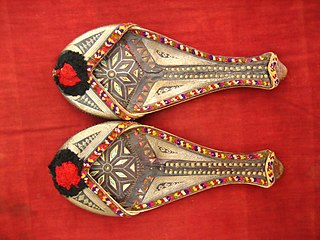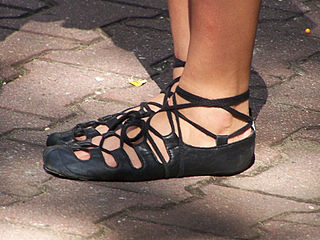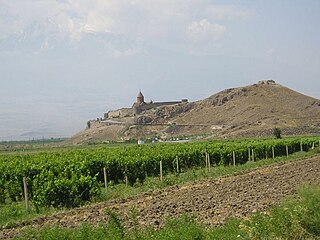
A shoe is an item of footwear intended to protect and comfort the human foot. Though the human foot can adapt to varied terrains and climate conditions, it is vulnerable, and shoes provide protection. Form was originally tied to function, but over time, shoes also became fashion items. Some shoes are worn as safety equipment, such as steel-toe boots, which are required footwear at industrial worksites.

Footwear refers to garments worn on the feet, which typically serve the purpose of protection against adversities of the environment such as wear from rough ground; stability on slippery ground; and temperature.

Clogs are a type of footwear made in part or completely from wood. Used in many parts of the world, their forms can vary by culture, but often remained unchanged for centuries within a culture.

Vayots Dzor is a province (marz) of Armenia. It lies at the southeastern end of the country, bordering the Nakhchivan exclave of Azerbaijan to the west and the Kalbajar District of Azerbaijan to the east. It covers an area of 2,308 km2 (891 sq mi). With a population of only 52,324, it is the most sparsely populated province in the country. The capital and largest city of the province is the town of Yeghegnadzor.

The Armenian Taraz, also known as Armenian traditional clothing, reflects a rich cultural tradition. Wool and fur were utilized by the Armenians along with the cotton that was grown in the fertile valleys. During the Urartian period, silk imported from China was used by royalty. Later, the Armenians cultivated silkworms and produced their own silk.

Sindhi Mojari is a type of handcrafted footwear produced in the Indian subcontinent. They are traditionally made by artisans mostly using tanned leather. The uppers are made of one piece of leather or textile embroidered and embellished with brass nails, cowry shells, mirrors, bells and ceramic beads. The bonding from the upper to the sole is done by cotton thread that is eco-friendly and enmeshes the leather fibers to strengthen the bonds. Some product range also uses bright and ornate threads.

Ghillies are specially designed shoes used for several types of dance. They are soft shoes, similar to ballet shoes. They are used by women in Irish dance, by men and women in Scottish country dance, and by men and women in Scottish highland dance.

Yelpin is a village in the Areni Municipality of the Vayots Dzor Province in southwestern Armenia, located on the Armenia–Azerbaijan border.
Research Cave, also known as the Arnold Research Cave and the Saltpetre Cave, and designated by the Smithsonian trinomial 23CY64, is a major Native American archaeological site near Portland, Missouri. Investigation of the site has uncovered evidence of human habitation as far back as 8,000 years. The site was designated a National Historic Landmark in 1964; it has been recommended for de-designation due to looting.

Areni is a village and the center of the Areni Municipality of the Vayots Dzor Province in Armenia. Areni is best known for its wine production, with the majority of wine produced locally from the nearby village of Getap.

Archaeology in Armenia has revealed many significant historical findings. Armenia is rich in Bronze Age sites and several Stone Age sites were recently identified on the slopes of the Aragats Mountain and are currently being excavated by Armenian and international teams. Archaeological excavations have taken place in the territory which is now the Republic of Armenia for about 150 years. Many sites, ranging from Stone Age to Early Iron Age, have been discovered and at least partly excavated. For the preservation and reconstruction of archaeological sites in Armenia, suggestions, and solutions have been proposed by L. Kirakosyan from National University of Architecture and Construction of Armenia.

Armenian wine is wine made in Armenia and the Armenian-populated Republic of Artsakh, in the region of South Caucasus. Armenia is one of the oldest wine producing regions of the world. In particular, the oldest known winery was found in Armenia's Areni region, which to this day is still known of its wine production and endemic grapes.
The year 2010 in archaeology
Pampooties are rawhide shoes, which were formerly made and worn on the Aran Islands of County Galway, Ireland.

The Areni-1 winery is an ancient winery that was discovered in 2007 in the Areni-1 cave complex in the village of Areni in the Vayots Dzor province of Armenia by a team of Armenian and Irish archaeologists. The excavations were carried out by Boris Gasparyan of the Institute of Archaeology and Ethnography of the National Academy of Sciences of Armenia and Ron Pinhasi from University College Cork (Ireland), and were sponsored by the Gfoeller Foundation (USA) and University College Cork. In 2008 the University of California, Los Angeles (UCLA) also joined the project with Gregory Areshian as co-director of the Areni Project. Since then the excavations have been sponsored by UCLA and the National Geographic Society as well. The excavations of the winery were completed in 2010.

The Areni-1 cave complex is a multicomponent site, and late Chalcolithic/Early Bronze Age ritual site and settlement, located near the Areni village in southern Armenia along the Arpa River.
Humanity has used animal hides since the Paleolithic, for clothing as well as mobile shelters such as tipis and wigwams, and household items. Since ancient times, hides have also been used as a writing medium, in the form of parchment.
Andin. Armenian Journey Chronicles is an epic documentary directed by Ruben Giney. The film centers on historical links between Armenians travelling to India, China and other countries on the Silk Road.

Gregory Areshian was an Armenian-American archeologist and historian who was a professor at American University of Armenia. He was the co-director of the international team of archeologists who, led by Boris Gasparyan, found the 5,500 years old shoe in and the oldest winery in Areni of which Areshian said:
For the first time, we have a complete archaeological picture of wine production dating back 6,100 years.














